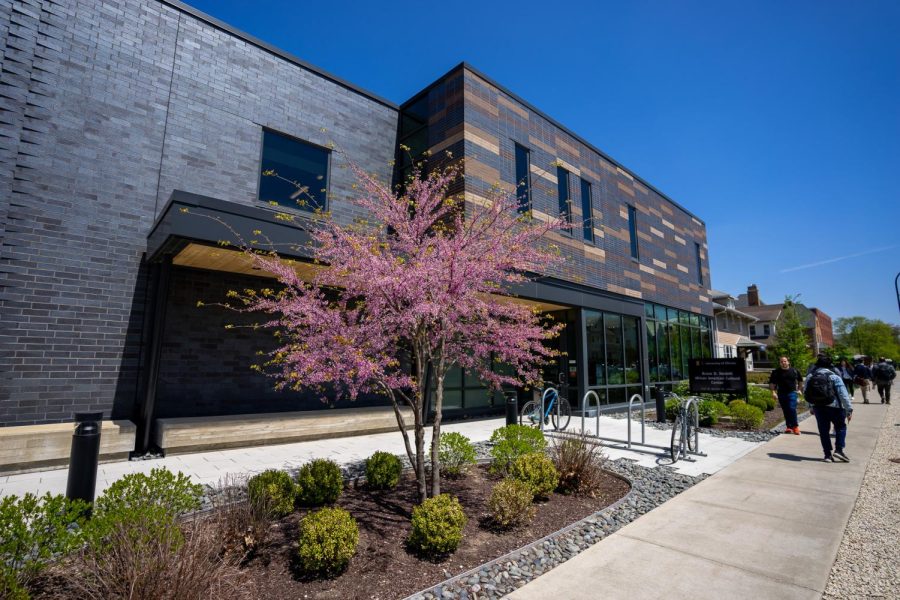Black Students for Revolution responds to recent events, discusses resources for Black students
The Bruce D. Nesbitt African American Cultural Center is located at 1212 W. Nevada St.
April 25, 2023
In an Instagram post on April 12, the Black Students for Revolution RSO on campus shared that they received racist and threatening responses in a survey seeking feedback from Black students.
“Over 50 responses called for direct violence against Black students, along with racist, derogatory remarks,” the post said.
Norman Hernandez, junior in AHS and future co-lead of BSFR, said the RSO initially put out the survey to gauge the feelings and the concerns that the Black student body had. Despite the racist messages, Hernandez said the RSO accomplished the original goal of the survey.
“In addition to the hateful responses, we did get a lot of positive responses from Black students that were very articulate about their concerns and things that they specifically wanted to see the BSFR accomplish,” Hernandez said.
Hernandez said that the negative responses demonstrate the necessity of BSFR’s work and advocacy efforts.
Get The Daily Illini in your inbox!
“We look at the hateful responses as … a reminder to the Black student body that things like this do happen and that we need to be prepared and establish things within the university that can help protect us,” Hernandez said.
According to Hernandez, BSFR aims to “unite the entire Black student body” while organizing them into politically educated activists. To achieve these goals, BSFR focuses on community events, issues pertinent to the Black student community and creating spaces which promote Black student success.
In response to the racist messages received in the survey, Chancellor Robert Jones sent out a campuswide Massmail on April 14 that condemned the “vitriolic expressions” rooted “in hatred, bigotry and intolerance.” The email recommended that anyone facing a direct threat of violence should call 911, reach out to counseling resources or report the incident on the Campus Belonging website.
According to the Massmail, the University administration has not received any reports “from anyone in (the) campus community who received a direct threat of violence that was indicated in the survey.”
Robin Kaler, spokesperson for the University, said the University of Illinois Police Department “have initiated an investigation into the threatening posts, and they have reached out to representatives of BSFR to obtain more information that would allow them to file subpoenas for digital evidence related to the survey responses.”
She added that UIPD investigates all reports of threatening activity within the campus community and students found to violate the Student Code are held accountable by the University.
Kennedy McClinton, sophomore in LAS and future BSFR co-lead, said the University’s actions are insufficient because they have not created all the necessary resources to make Black students feel safe.
“The concerns of Black students should not just have to be fixed with the UIPD,” McClinton said. “There has to be something in place and Chancellor Jones dismissing us and what Black students stand for is not okay.”
Hernandez added that the University puts on a “grand display” of diversity and equity inclusion while brushing off Black voices.
If these issues remain, Hernandez said hate toward Black people will continue to grow.
“A lot of people seem to think that this might be an isolated incident … but there’s been plenty of examples of racist culture that have been at the University,” Hernandez said.
In 2020, a Facebook Page titled “Illini White Student Union” resurfaced following protests in the wake of George Floyd’s death.
Falsely associated with the University, the social media account posted under the hashtag “All Lives Matter.” The page was first created in 2015 as a response to the Black Lives Matter activists on campus and still exists today with almost 5,000 followers.
“The more you permit people to do things like this, the farther they feel comfortable pushing on,” Hernandez said.
Khalia Mullen, sophomore in LAS and future BSFR co-lead, said that even though the University appears multicultural, the Black student population is a small subset of the entire student body.
“We are under the guise that this community is very diverse, as we see in the numbers specifically, but the Black population here is not as big as we all believe,” Mullen said.
According to self-reported data from the Division of Management Information, the number of Black students enrolled declined for the first time in eight years from 6.8% in 2021 to 6.5% in 2022.
Mullen said BSFR hopes to increase the number of Black students and staff on campus. Their newest initiative, called Project 1000, aims to graduate 1,000 Black students each year.
The project references the history of the Black student population on campus, when in the 1960s, Project 500 was created to recruit underrepresented minority communities on campus. However, after miscommunication about housing options, recruited students protested and over 200 were arrested.
The future BSFR leaders noted the consolidation of minority academic units on campus presented another key concern over the potential loss of resources. In 2021, the College of Liberal Arts and Sciences announced plans for a new building to house ethnic, gender and women’s studies.
“There should be no reason why there is a creation of ethnic studies because all of us need our own places,” McClinton said. “We all go through our own problems.”
Echoing McClinton’s sentiments, Mullen said that the consolidation of cultural units is “unproductive” as it silences Black voices as well as the voices of other marginalized people on campus.
According to Kaler, “the new building for our academic ethnic, gender and women’s studies unit will be a significant enhancement of their current conditions” and follows the trend of other academic buildings that house several departments, such as Lincoln Hall.
In light of the recent incident and the challenges that the Black student body is facing, Hernandez said that BSFR is forming a coalition of Black students and Black organizations to unite their voices and enact change.
“We are trying to spearhead this initiative and bring everyone together,” Hernandez said. “I think the biggest thing that the university can do right now is … (to listen to) any of the Black organizations that are calling for structural change.”








